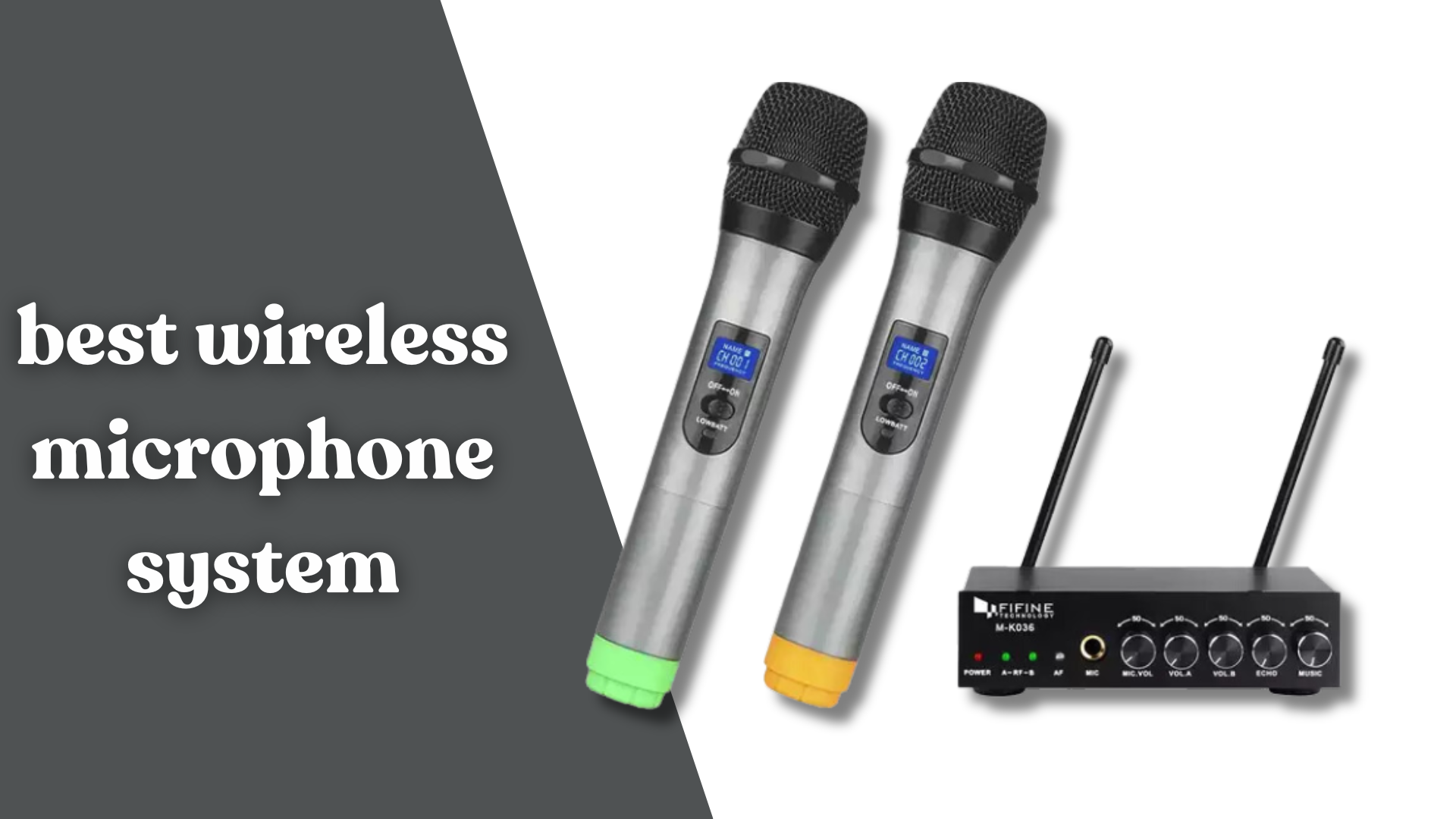In general, we think that microphone systems are only used during on-stage live performances. However, it is not the situation today. The microphone systems are used for recording vlogs, podcasts, live streams, videos, and other vocal recording stuff for improved audio delivery. Therefore here is a list of the Best Wireless Microphone Systems.
These microphones not only make the audio recording easier but also free you from the hassle of tangling wires. So, without wasting any further time, let’s dig into the article.
Audio-Technica System 10 ATW-1102n
This futuristic system runs at an advanced 24-bit operation speed in the 2.4 GHz range. The system provides the specs of a professional, hi-fi system at a budget price. From diverse operation, automatic scanning, and easy user interface to interference-free performance, Audio-Technica has covered you by all means.
The device can automatically determine and work on the est frequency available, as soon as it is turned on. It can connect up to eight channels/systems at a time without any issue regarding overlapping or lagging. Moreover, its easy-to-read LED display also shows you all the details of the setting and operation system.
Additionally, its ground-lift switch also eliminates all the unnecessary ground oop, system operation, and receiver noises to provide an even clearer audio experience. Hence, in my opinion, for its budget price, the microphone system has admirable features.
| Operating frequency range | 2.4 GHz | Audio frequency response range | 20 to 20 000 Hz |
| Audio outputs | XLR audio output,6.35 mm | Receiver type | Digital receiver |
| Antennas | Dual-antennas (detachable) | Display type | Backlit LCD |
| Display purpose | Showing channel, signal strength, battery percentage | Sensitivity | -90 dBm |
| Audio Output Level | 6 DVB | Dynamic range | 109 dB |
| Total harmonic distortion (THD) | Less than 0.05 percent | Signal-to-noise ratio | More than 109 dB |
| Wireless working range | 100 feet | Bit depth | 24-bit (48 000 Hz) |
| Power consumption | 12 Volts (Direct Current) | Built0in power supply or batteries | No |
| Length | 8 inches | Width | 2 inches |
| Height 5 inches | Mic type | Dynamic | |
| Polar pattern | Cardioid | Power output | 10 mW |
| Battery timing of mic | 7 hours | Battery type | Alkaline batteries |
| Battery requirement | 2x 1.5 Volts | Diameter of mic | 2 inches |
| Length of mic | 10 inches |
Pros
- The audio quality is exceptional at 24-bit and 48 kHz
- The frequency can be selected automatically
- 2.4 GHz operating frequency range
- Small and lightweight
- Very portable
- Average battery life
Cons
- The operating range is very low (around 100 feet)
- 2.4 GHz can be crowded by the environment
- Batteries have to be charged or replaced
- Only one microphone in the pack
- No prominent advanced features
Shure PGXD24/SM58
When the microphone is paired up with PGDX4, it delivers crystal clear and phenomenal 28 KHz digital audio. Its dual antennas and one-touch scanning features allow you to get a rock-solid connection and enjoy the high-pitched, notched audio quality.
Moreover, it has a BETA 58A cardioid Dynamic Microphone Capsule for digital and wireless transmissions. Further, its automatic frequency selection can locate and connect the most clean frequency channel. Additionally, it has the compatibility to connect to 5 additional channels per bandwidth. In my opinion, the channel range is quite minimal and these channels might get overcrowded sometimes.
Moreover, it is a little overpriced if we compare it with the specs it offers. However, if you are looking for a simple, compatible, and durable microphone system with good audio quality, then you can surely check on Shuru PGXD24/SM58 in the market.
| Frequency range | 2.4 GHz | Operating wireless range | 61 meters |
| Transmitter type | Digital | Diversity antenna | Internal antennas |
| Display type | LCD | Display usage | Shows channel, signal, battery info |
| Audio output | ¼ inches,XLR outputs | Channel selection | One-tap sync |
| Audio frequency response range | 20 to 20 000 Hz | Total Harmonic Distortion | Less than 0.02 percent |
| Dynamic range | 108 dB | Signal-to-noise ratio | More than 90 dB |
| Transmitter type | Handheld | Microphone Capsule | Shure SM58 |
| Mic type | Dynamic | Polar pattern | Cardioid |
| Output power | 10 mW | Battery timing | 9 hours |
| Batteries | 2 AA | Working temperature | -18 to 50 degrees Celsius |
| Weight | 320 grams | Height | 4 cm |
| Width | 18 cm | Depth | 10 cm |
| Diameter of mic | 5 cm | Length of mic | 25 cm |
| Weight | 290 grams |
Pros
- The sound quality is awesome
- Very reliable and durable
- Provides wireless connectivity
- 2.4 GHz operating frequency range
- Very easy to set up and use
- A long wireless range of 61 meters without obstacles
- Effective antennas to catch signals
Cons
- The frequency range can get crowded sometimes
- The channel options are minimal
- Batteries have to be charged and replaced frequently
- The digital interface is not useful
- The cost of this mic system is a bit higher
GTD Audio G-733H
The GTD Audio G-733H surely lies in the professional range for its awesome sound quality and 800 selectable channel range. Moreover, its advanced features also include automatic frequency scanning, true diversity operation, a Tone Lock squelch circuit, and an automatic transmitter setup.
Further, its backlit LED display also shows the setting and configuration information, along with the channel frequency and mute status. Its automatic frequency scanning can locate and connect the best frequency channel available at the spot. It has a dual-channel receiver, and both channels can be operated at the same time. Whereas, it offers individual volume control for each channel. It features a wide 600 feet signal range and a 35 Hz to 18 KHz frequency response.
The battery life supports recording for up to 12 hours on a single battery recharge. All these amazing features make it a perfect choice for vocal professionals to grab at any event. However, it is important to mention that the design is not very durable and the display doesn’t show any important information. Furthermore, it doesn’t include a compressor and equalizer.
Overall, the GTD Audio G-733H has impressive sound quality and advanced features. It offers professionals an exceptional wireless microphone system with capabilities for precise control and reliable performance.
| Operating frequency range | Ultra high frequency | Operating wireless range | 600 feet |
| Audio frequency response range | 35 to 18 000 Hz | Number of selectable channels | 800 channels |
| Battery timing | 12 hours | Batteries | AA batteries |
| Rack-mountable | Yes (19 inches) | Polar pattern | Cardioid |
| Automatic transmitter setup | Yes | Receiver channels | Dual- channel |
| Audio output type | 2x XLR, 6.35 mm mixed output | Volume controls | Yes |
| Weight | Unknown | Length | 17.5 inches |
| Width | 13.5 inches | Height | 3.5 inches |
| Power amplifier | Yes |
Pros
- Hundred of selectable channels
- Ultrahigh operating frequency band
- Long coverage of 600 feet
- Long battery life of up to 12 hours
- Has rack-mountable microphone
Cons
- The frequency response range is lower
- No display to show important info
- The equalizer and compressor are also unavailable
- Not so durable
Behringer Ultralink ULM302MIC
This microphone is specially designed to improve your vocal quality. With its two handheld microphone transmitters you’ll never go wrong with your audio quality during the live performance or streaming. Its durable battery can for up to 1 day without a need to recharge.
Further, it has an operating range of 200 feet with minimal or no sound interference. It also features a built-in volume button and a quick mute button to handle any panic or inconvenience. Its 2.4 GHz band is tailor-made to reduce any risk of signal lapping or unnecessary intrusion. The signals are digitally encrypted to avoid any unwanted artifacts.
Moreover, it also includes a Balanced XLR and unbalanced TS connector for better and smoother signal integration. However, the microphone system doesn’t include any advanced or top-notch features, that can amaze the buyer. The material quality too looks a little cheap. This makes it a little unpopular in the market. However, for its price range, its features are quite fascinating.
| Frequency band | Ultra-high frequency (UHF) | Working wireless range | Few hundred feet |
| Mic type | Dynamic, Handheld | Polar pattern | Cardioid,Super cardioid |
| Batteries | AA batteries | Battery timing | Unknown |
| Total Harmonic Distortion | Low | Audio frequency response range | 20 to 20 000 Hz |
| Output power | Adjustable | Channel selection | Multiple channels |
| Audio output type | 6.35 mm TRS output,XLR audio output | Display type | LCD |
| Display usage | Shows channel, signal strength, battery life | Antennas | Dual antennas |
| Signal-to-Noise ratio | High | Weight | 0.7 lbs |
| Length | 15 cm | Width | 12 cm |
| Depth | 4 cm | Length of mic | 5 cm |
| Width of mic | 5 cm | Height of mic | 26 cm |
Pros
- It comes with an ultra-high-frequency band
- One package contains 2 microphones
- Simple connectivity with wireless technology
- Very budget-friendly option
- Can cover a distance of a few hundred feet without obstacles
- Very easy to use
- Dynamic microphone
Cons
- No advanced microphone system features
- The user has to take care of batteries (recharging and replacement)
- The material and build look cheap
- Audio quality is not up to the mark
Bottom Line
In conclusion, wireless microphone systems have evolved beyond live stage performances and are now vital for various applications like vlogging, podcasting, and video production. While each of the mentioned microphone systems has its strengths and limitations, it’s important to choose the one that best suits your specific needs.
Consider factors like operating range, sound quality, and advanced features to make an informed decision. Ultimately, the ideal wireless microphone system should strike a balance between performance and affordability to enhance your audio recording experience.

